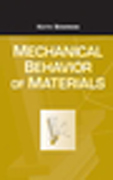
An understanding of mechanisms for mechanical behavior is essential to applications of new materials and new designs using established materials. Focusing on the similarities and differences in mechanical response within and between the material classes, this book provides a balanced approach between practicalengineering applications and the science behind mechanical behavior of materials. Covering the three main material classes: metals, ceramics and polymers, topics covered include stress, strain, tensors, elasticity, dislocations, strengthening mechanisms, high temperature deformation, fracture, fatigue, wear and deformation processing. INDICE: Chapter 1. Introduction. 1.1 Strain 1.2 Stress. 1.3 Mechanical Testing. 1.4 Mechanical Responses to Deformation. 1.5 How Bonding Influences Mechanical Properties. 1.6 Further Reading and References. 1.7 Problems. Chapter 2. Tensors and Elasticity. 2.1 What Is a Tensor? 2.2 Transformation of Tensors.2.3 The Second-Rank Tensors of Strain and Stress. 2.4 Directional Properties.2.5 Elasticity. 2.6 Effective Properties of Materials: Oriented Polycrystals and Composites. 2.7 Matrix Methods for Elasticity Tensors. 2.8 Appendix: The Stereographic Projection. 2.9 References. 2.10 Problems. Chapter 3. Plasticity.3.1 Continuum Models for Shear Deformation of Isotropic Ductile Materials. 3.2 Shear Deformation of Crystalline Materials. 3.3 Necking and Instability. 3.4Shear Deformation of Non-Crystalline materials. 3.5 Dilatant Deformation of Materials. 3.6 Appendix: Independent Slip Systems. 3.7 References. 3.8 Problems. Chapter 4. Dislocations in Crystals. 4.1 Dislocation Theory. 4.2 Specification of Dislocation Character. 4.3 Dislocation Motion. 4.4 Dislocation Content in Crystals and Polycrystals. 4.5 Dislocations and Dislocation Motion in Specific Crystal Structures. 4.6 References. 4.7 Problems. Chapter 5. Strengthening Mechanisms. 5.1 Constraint Based Strengthening. 5.2 Strengthening Mechanisms in Crystalline Materials. 5.3 Orientation Strengthening. 5.4 References. 5.5 Problems. Chapter 6. High Temperature and Rate Dependent Deformation. 6.1 Creep.6.2 Extrapolation Approaches for Failure and Creep. 6.3 Stress Relaxation. 6.4 Creep and Relaxation Mechanisms in Crystalline Materials. 6.5 References. 6.6 Problems. Chapter 7. Fracture of Materials. 7.1 Stress Distributions Near Crack Tips. 7.2 Fracture Toughness Testing. 7.3 Failure Probability and Weibull Statistics. 7.4 Mechanisms for Toughness Enhancement of Brittle Materials. 7.5Appendix A: Derivation of the Stress Concentration at a Through-Hole. 7.6 Appendix B: Stress-Volume Integral Approach for Weibull Statistics. 7.7 References. 7.8 Problems. Chapter 8. Mapping Strategies for Understanding Mechanical Properties. 8.1 Deformation Mechanism Maps. 8.2 Fracture Mechanism Maps. 8.3 Mechanical Design Maps. 8.4 References. 8.5 Problems. Chapter 9. Degradation Processes: Fatigue and Wear. 9.1 Cystic Fatigue of materials. 9.2 Engineering Fatigue Analysis. 9.3 Wear, Friction, and Lubrication. 9.4 References. 9.5 Problems. Chapter 10. Deformation Processing. 10.1 Ideal Energy Approach for Modelingof a Forming Process. 10.2 Inclusion of Friction and Die Geometry in Deformation Processes: Slab Analysis. 10.3 Upper Bound Analysis. 10.4 Slip Line Field Analysis. 10.5 Formation of Aluminum Beverage Cans: Deep Drawing, Ironing, andShaping. 10.6 Forming and Rheology of Glasses and Polymers. 10.7 Tape Castingof Ceramic Slurries. 10.8 References. 10.9 Problems. Index.
- ISBN: 978-0-471-24198-0
- Editorial: John Wiley & Sons
- Encuadernacion: Cartoné
- Páginas: 368
- Fecha Publicación: 14/05/2008
- Nº Volúmenes: 1
- Idioma: Inglés
